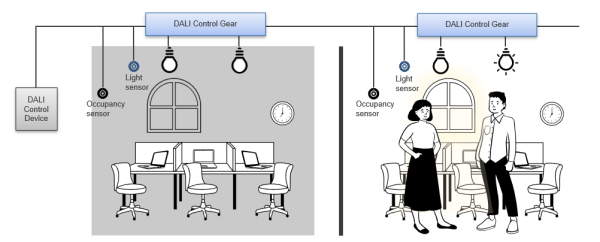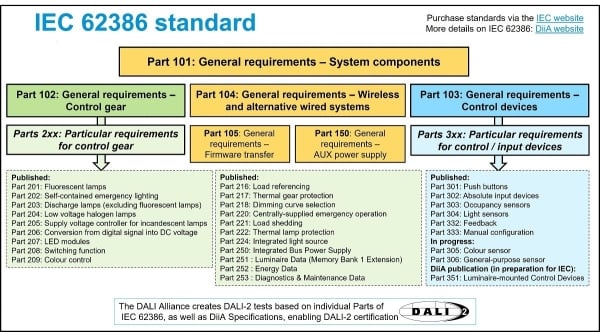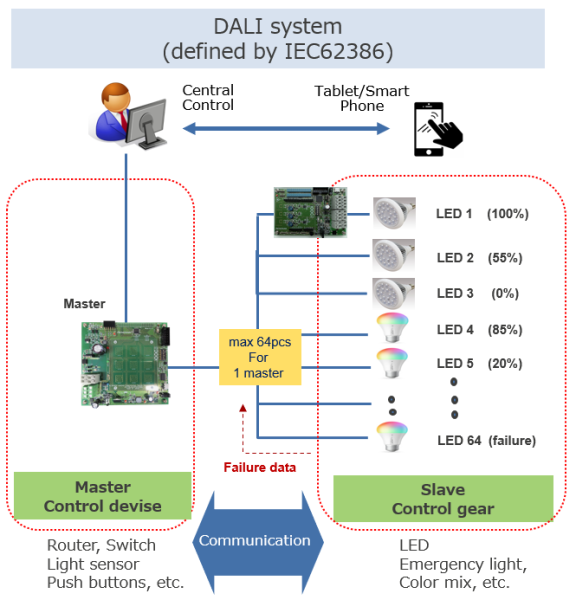Before diving into this blog, if you want to know more about DALI lighting control, start by reading the DALI Lighting Control: A Sustainable Solution for the Future’s Green Buildings blog.
The Integration of IoT and DALI Lighting
With the development of IoT technology, the DALI lighting system has evolved significantly. The core of IoT lies in the connection and data exchange between various devices. Applying this technology to the DALI lighting system enables smart lighting solutions. This includes integrating sensor technology into the DALI lighting system to sense the surrounding environment and then automatically adjust the lighting.
For example, using light sensors to monitor natural light indoors in real time and then automatically adjust the indoor lighting brightness accordingly can supplement the light level. Such a dynamic adjustment can make the indoor environment more balanced and comfortable while also achieving energy savings. Similarly, using presence sensors can detect whether there are people in the room and automatically turn on the lighting system when someone is present. This automation not only improves energy efficiency but also enhances user convenience. Therefore, by combining IoT technology with the DALI lighting system, a more intelligent, energy-efficient, and comfortable lighting system can be realized.
Related Standards and Solutions
To better integrate IoT with the DALI lighting system, the Digital Illumination Interface Alliance (DiiA) has published the 30x series of standards. This article focuses on explaining Parts 301, 302, 303, and 304.
- Part 301 (Push buttons): A standard for input devices designed for button operations.
- Part 302 (Absolute input devices): A standard for input devices such as volume controls and sliders.
- Part 303 (Occupancy sensors): A standard for input devices that detect human movement or presence and convey room occupancy information.
- Part 304 (Light sensors): A standard for input devices that detect light intensity levels and convey luminance information.
The impact of these standards on the design and functionality of lighting systems:
- Clear requirements for input devices: The DALI standard specifies the requirements for input devices in lighting systems, such as switches and sensors. This enhances the system’s responsiveness and flexibility, improving its adaptability to various situations. It also increases the compatibility and reliability between systems.
- Standardization of sensors and controllers: The DALI system is advancing the standardization of sensors and controllers. This enables lighting systems to respond more effectively to environmental changes. For instance, lighting can be automatically adjusted based on the presence of people and changes in natural indoor light, leading to smarter lighting solutions.
- Optimized energy use and cost reduction: By promoting the efficient use of energy and reducing operational costs, automatic lighting adjustment helps to reduce unnecessary power consumption. This is also a crucial aspect in achieving Sustainable Development Goals (SDGs).
Renesas offers solutions including evaluation boards, software, application notes, and GUIs for the DALI lighting system standards 201 to 304 published by DiiA. This enables customers to evaluate boards and develop products more quickly and conveniently.
For more information on related products, please refer to the following URL:
RTK7RL23LMP00000BJ - RL78/G23 Lighting Communication Master Evaluation Board
In addition to the evaluation board for control devices compatible with the 30x standards, a control gear evaluation board (RL78/G24 DC/DC LED Control Evaluation Board) equipped with the RL78/G24, the most powerful processor in the history of the RL78 series of MCUs, has also been announced. This can be used to control individual lighting devices. Moreover, it can be integrated with control devices to construct a complete lighting control system.
As a regular member of DiiA, Renesas actively participates in the consideration of new standards, continually develops new technology stacks, and keeps up with the latest lighting control requirements. Let’s take a step towards realizing sustainable and comfortable buildings in the future using Renesas’ DALI solutions.
Digital Illumination Interface Alliance (DiiA) is an industry consortium aimed at promoting the adoption and development of the DALI lighting communication standard. DiiA develops technical specifications for DALI and implements certification programs for compliant products.




